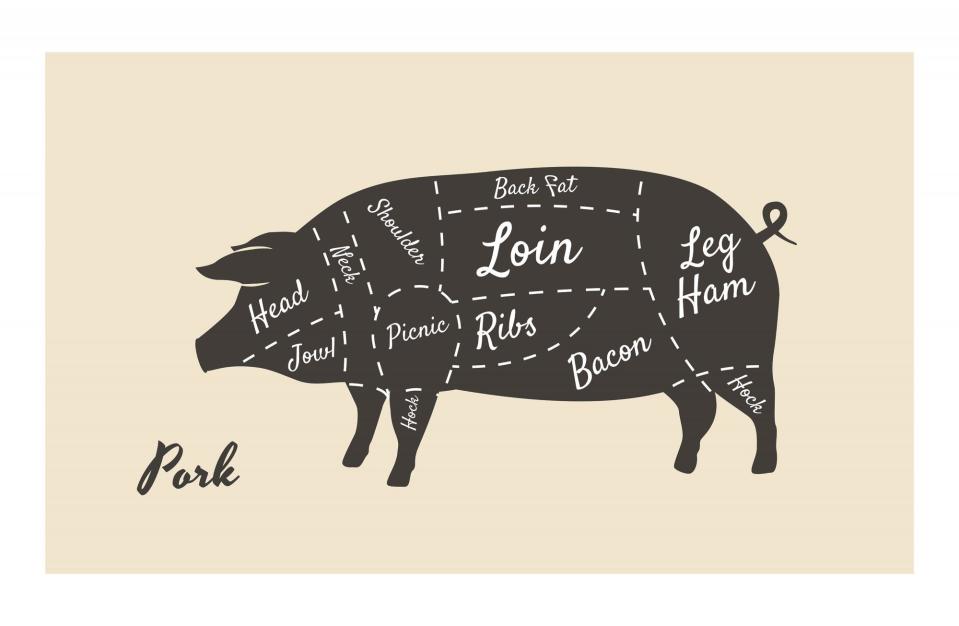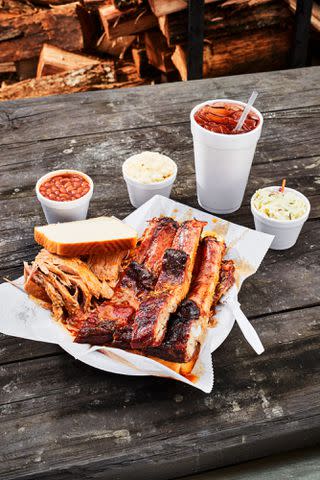What Is Boston Butt And How Did It Get That Name?
Know your cuts of meat.

It has always seemed funny to me that one of the most popular cuts of pork for Southern barbecue pits has an inherently Yankee name: the Boston butt.
The second half of the name—the butt part—has led to all sorts of cutesy names for competition barbecue teams and restaurants (Big Butts, Rubbin' Butts, Smokin' Butts.) It offers endless opportunities for titillating restaurant slogans, like "No One Can Touch Our Butts" and "You Can Smell Our Butts for Miles." Naturally, you may wonder where the name Boston butt came from and what part of the pig it refers to.
Which Part Of The Pig Is "Boston Butt"?
A Boston butt has nothing to do with a pig's backside—that's the ham. The butt, counterintuitively, comes from the front end.
You can buy a whole pork shoulder at some grocery stores, but you'll commonly find the shoulder cut into two pieces. The upper part is the oddly-named Boston butt (sometimes called "blade roast"), and it comes from right behind the pig's neck and typically contains a small piece of the shoulder blade. The lower part is called the picnic ("arm roast") and includes the rest of the leg down to the hock.
Where Did The Name "Boston Butt" Originate?
So, that's the proper location for these meats. But how to explain the name?
If you believe the Internet, it came from shipping practices. Back in the colonial days, an article in Mental Floss explains, New England butchers took "less prized cuts of pork," packed them into barrels, and shipped them off to other places. "The barrels the pork went into were called butts," the author explains. "This particular shoulder cut became known around the country as a New England specialty, and hence it became the 'Boston butt.'"

Why We're Skeptical Of The Internet
The New York Times and other reputable publications have repeated this story, but common sense should make us skeptical. Can you think of any other food named for its shipping container name?
There are plenty of historical problems with this explanation, too. For starters, Virginia and North Carolina, not New England, were the centers of the pork trade in the 18th century until eclipsed by Cincinnati in the 1830s and then by Chicago. I have searched high and low but cannot find a single printed use of the term "Boston butt" in the colonial era or even before the Civil War.
How Cuts Of Meat Got Named For Geography
The term originated in the late 19th century, as railroads transformed the commercial meat packing industry from regional to national. Butchers in different parts of the country had slightly different ways of carving up pigs and cows. Other states and cities lent their names to various cuts as national packers standardized butchering. Thus we have New York Strip steaks and St. Louis-style ribs—another favorite of Southern barbecue cooks.
The pork shoulder originally had several other geographically-named cuts. In the meatpacking trade, the Kansas City Sun reported in 1892, "careful requirements are formulated for standard sweet pickled hams and shoulders, New York shoulders, Boston shoulders, California hams, skinned hams, pickled bellies, etc."
According to agriculture journals and meat cutter manuals from the early 20th century, New York shoulders had the shank "cut off above the knee, trimmed close and smooth, and square at the butt." A "California ham" was not ham at all. It was "well-rounded at the butt, and trimmed as near to the shape of a ham as possible." This latter cut was also known as the "picnic" (for reasons I've been unable to discover), and that term is now the standard for the lower part of the pork shoulder.
Here's A Better Explanation For "Boston Butt"
As the use of "butt" in these agricultural manuals suggests, the name of the Boston-style cut had nothing to do with shipping containers. Consider the butt of a rifle or a cigar butt. Either crafty Bostonians were putting all sorts of things in barrels and shipping them south, or "butt" was simply a generic term for, as Merriam-Webster phrases it, "the large or thicker end part of something"—the pork shoulder, in this case.
Boston didn't have a monopoly on butts, either. The 1912 Bulletin of the Agricultural Experiment Station of the University of Illinois at Urbana-Champaign observed, "Milwaukee style butts are the same as Boston butts with the neck bone and rib left on." My research even turned up a passing mention of a "New Orleans cut" of pork shoulder in 1911, but that one never became popular, which is a shame.
So, the next time you fire up the backyard pit, feel free to buy a couple of Boston butts if you prefer. There's no need to giggle about the name, even while rubbing them down with your secret spice blend.
For more Southern Living news, make sure to sign up for our newsletter!
Read the original article on Southern Living.

